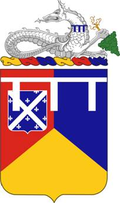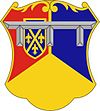66th Armor Regiment (United States)
| 66th Armor Regiment | |
|---|---|

66th Armor Regiment coat of arms
|
|
| Active | 1918–present |
| Country |
|
| Branch |
|
| Type | Armor |
| Role | Armored warfare |
| Size | Two battalions |
| Garrison/HQ | Fort Carson, CO (1st Bn); Fort Riley, KS (3rd Bn) |
| Nickname(s) | "Burt's Knights" |
| Motto(s) | Semper in Hostes |
| Engagements |
World War I World War II Korean War Operation Desert Storm Iraq War |
| Commanders | |
| Notable commanders |
George S. Patton (304th Tank Brigade) |
| Insignia | |
| Distinctive unit insignia |  |
The 66th Armor Regiment is the oldest armored unit in the United States Army (see Iron Knights: the United States 66th Armored Regiment, by Maj. Gordon A. Blaker), tracing its lineage to the 301st Tank Battalion which served with distinction soon after it was formed in the First World War; the 301st trained at Camp Meade, MD, where then Cpt. Dwight D. Eisenhower was an instructor. It has often been rumored that the 301st, the parent unit of the 66th, was first commanded by Col. George S. Patton, but this appears not to have been the case; while Patton was the first officer assigned to the Tank Corps, and while the 301st Tank Battalion was the first unit formed, Patton went nearly immediately to France to train Americans attached to Allied commands. The 301st was the only American heavy tank battalion to have seen action in the war. After the war, the 301st transitioned in the Regular Army to become the 66th Infantry Regiment (Light Tanks) by way of the 16th Tank Battalion.
Two battalions of the regiment are still in service in the Regular Army.
The 1st and 2nd Provisional Brigades of the United States Tank Corps would eventually go on to provide the original cadre for what would become the 66th Armored Regiment in World War II. In September 1918 both brigades - which were attached to the 1st Infantry Division in France - participated in the battle of St. Mihiel and the Meuse-Argonne Offensive, operating French-built Renault FT tanks. Five days before the Armistice with Germany, the brigades were renamed respectively the 304th and 305th Brigades, Tank Corps on 6 November 1918.
The casualties in the unit led General John J. Pershing to say: "The percentage of casualties among the officers and men tells the tale of splendid morale and gallantry in action and their unselfish devotion to duty". The regiment's Organization Day was chosen as 12 September to commemorate its baptism of fire at St. Mihiel.
...
Wikipedia
